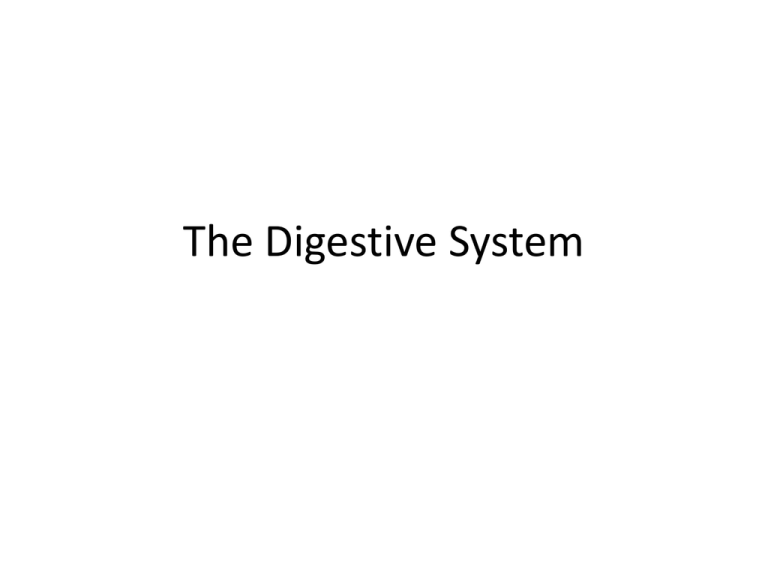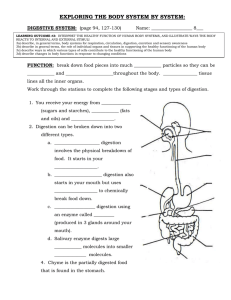Notes - The Digestive System
advertisement

The Digestive System Nutrition • Food provides the energy for metabolism and the raw materials for building and repairing body parts. • The process of getting the food needed to survive = nutrition. – The raw materials the body gets from food = nutrients. • Carbohydrates, proteins, fats, vitamins, minerals and water. Process of Digestion • The process of breaking down food into smaller nutrient molecules by the digestive system – digestion. – 3 Main Functions: 1. Break down food into molecules the body can use. 2. Absorption of digested particles into the blood to be carried throughout the body. 3. Removal of wastes from the body. Types of Digestion • 2 Types of Digestion: – Mechanical Digestion – the physical breaking apart of food particles into smaller pieces. • Biting food, chewing, grinding and tearing – Chemical Digestion – the digestion of food particles by enzymes. • Enzymes are proteins that speed up chemical reactions. – Saliva, bile and stomach acids The Path of Digestion 1. 2. 3. 4. 5. 6. 7. Mouth Esophagus Stomach Small Intestine Large Intestine Rectum Anus 1. 2. 3. 4. 5. 7. 6. www.aboutkidsgi.org Path of Digestion 1. Mouth a. Food enters the digestive tract -ingestion. i. Teeth chew and grind the food – mastication. ii. Saliva mixes with food. i. The mass of chewed food is now called a bolus. 2. Esophagus a. Transports food from the mouth to the stomach. i. Esophagus is Greek for “to carry what is eaten”. ii. Food is prevented from passing into the lungs by the epiglottis. o As food passes over the epiglottis it covers the opening of the trachea so food can’t pass down it. Path of Digestion iii. Food is moved down the esophagus by one-directional muscular contractions - peristalsis Path of Digestion 3. Stomach a. The majority of the digestion taking place here is MECHANICAL digestion. i. Muscular contractions break the food into smaller pieces. b. A smaller portion of the digestion taking place here is chemical. a. Food also mixes with gastric juices. c. The liquid mass of food is now called chyme. Path of Digestion 4. Small Intestine a. 2.5 cm wide and over 6 meters long. b. Food enters as a soft, watery substance - chyme. c. Most digestion here is in the form of chemical digestion. i. “Digestive helpers” help to break down the food further by adding digestive enzymes here. • NO food passes through any of these organs! d. Absorption of nutrients, by villi, into the blood stream. i. Villi – fingerlike projections that increase the surface area of the small intestine. Villi Digestive Helpers A. Liver • The body’s largest and heaviest internal organ. o • Located to the right of the stomach. Produces the digestive enzyme bile. o Breaks up fat molecules. B. Gallbladder • Small pea sized organ, green in color, that stores bile. C. Pancreas • • A triangular organ located between the stomach and the small intestine. Produces: o o Insulin – controls sugar levels. Pancreatic juices – breaks down proteins, starches and fats. Digestive Helpers Path of Digestion 5. Large Intestine a. 6.5 cm wide and 1.5 meters long. b. Most nutrients have been removed at this point but indigestible materials and water remain. i. Water absorption is the main process taking place here. • Body reuses the water to keep from becoming dehydrated. ii. Material is turned into a solid waste product – feces. iii. Natural bacteria in the large intestine help to break down indigestible materials. i. Byproduct of these bacteria is gas. Path of Digestion 6. Rectum a. Stores the solid waste until its ready to be released from the body. 7. Anus a. The opening through which solid waste is removed from the body. Parastalsis Animation – 1:10min Mechanical or Chemical Digestion? Location/ Action Mouth Teeth Saliva Glands Esophagus Stomach Small Intestine Large Intestine Rectum Anus Mechanical Chemical No Digestion









